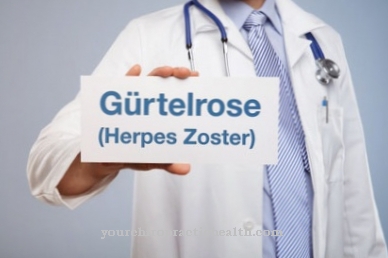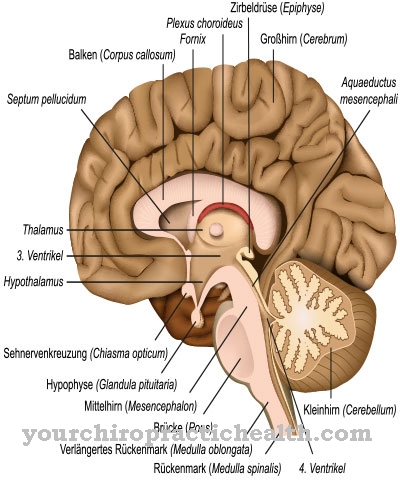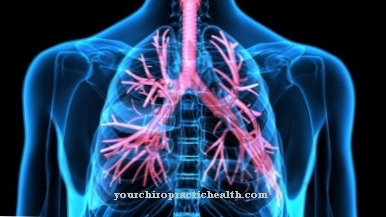The Shingles, its technical term Herpes zoster is is a viral infection. Your main symptoms are burning pain and a blistering rash. The virus responsible, Varicella Zoster Virus (VZV), was already present in the body when the disease broke out. Shingles only occurs in patients who have already had chickenpox, as the virus is the trigger and cause of both diseases.
What is shingles?

Shingles, also known as herpes zoster or zoster, is an infectious skin disease. It is triggered by the varicella zoster virus (VZV), which is one of the herpes viruses. It is also the causative agent for chickenpox. Only people who are already sick with chickenpox can get shingles. This infection is therefore also referred to as a second infection.
The name shingles is derived from the typical skin rashes that cause swollen and reddish blisters that wrap around the body on the spine. Since chickenpox mostly appeared in the childhood of those affected, mostly adults and older people (between the ages of 60 and 70) develop shingles. The disease is hardly contagious.
causes
As already mentioned, the varicella zoster virus (VZV) is responsible for both chickenpox and shingles. Shingles can only occur if the patient has previously had chickenpox. Therefore, the disease usually only occurs in older people (often after the age of 45).
The shingles virus spreads on the nerve fibers to the nerve nodes (spinal ganglia) that are present on the spine. The varicella zoster virus embeds itself in the nerve cells. Thereafter there can be no abnormalities for years. The virus is only reactivated in old age and develops into the familiar shingles. It is still unknown why the virus takes a long time to reactivate.
Shingles often affects people with immunodeficiency or susceptibility to infection. Hereditary or genetic causes within a family can also play a role. Stress and psychosomatic problems can also trigger shingles.
In rare cases, the pathogen is also transmitted directly without the person affected already contracting chickenpox. However, he must have had direct contact with the blisters of a shingles patient. But then he first gets sick with chickenpox and not with shingles itself.
You can find your medication here
➔ Medicines for rash & eczemaSymptoms, ailments & signs
With shingles, a painful rash forms, which usually starts from the spine and spreads around the body like a belt. Because the rash is mostly limited to this region. The skin is moderately to severely reddened and nodular lesions develop that are grouped into foci.
After some time in the course of the disease, joking bubbles from the size of a pinhead to the size of a pea develop from the nodules. Often these blisters are filled with a bloody or watery liquid. In the later course of the disease, the vesicles can fuse and later break open.
Before the typical skin rash of shingles occurs, those affected often feel generally ill, which is also accompanied by tiredness or a slight fever. This feeling of illness increases significantly in the first days of the illness. There is severe, burning pain in the area of the body that is later affected by the rash.
Many sufferers experience paresthesia. These are sensory disturbances in the affected parts of the body, which can be expressed as a sensation of cold or heat, tingling, itching or numbness. In rare cases, shingles can lead to paralysis.
course
Shingles usually progresses without complications.
Although treatment by a doctor makes sense, around 60 percent of all cases heal on their own within two to four weeks. Most of the time, only pigmented areas of skin remain, which appear either paler or tanned.
Nevertheless, severe pain can also arise during the course of shingles. If the burning pain is too severe, a doctor should consider pain therapy.
Complications
Complications from shingles occur in around 20 percent of all cases and are therefore relatively common.These are particularly difficult in immunocompromised patients, but treatment started late also increases the risk of secondary diseases. If shingles spreads over the head and face, viruses can settle on the auditory or optic nerve and in the worst case lead to loss of hearing or vision.
When viruses enter the brain, life-threatening meningitis can be the result. If the immune system is severely weakened, the zoster viruses occasionally settle in the whole body and also attack internal organs. A very painful and not uncommon complication of shingles is the so-called postherpetic neuralgia, in which the typical pain can be felt long after the rash has healed due to nerve damage - in some cases it even lasts for life.
The risk of this long-term persistence of herpes zoster pain increases with age, but can be reduced by starting treatment early. Even less dramatic shingles often results in bacterial infections, pigment disorders or scarring, as well as paralysis and sensory disorders in the area of the previously damaged skin.
When should you go to the doctor?
If shingles is suspected, the doctor should be consulted immediately. Patients can contact their family doctor. Outside of the office hours, for example on weekends or on public holidays, no time should be lost. During these times, patients can contact the emergency department of the regional hospital or an emergency practice. The earlier the treatment of shingles begins, the easier it is to alleviate the course of the disease and promote rapid healing.
Hoping that shingles will go away on its own makes absolutely no medical sense. In any case, shingles requires professional treatment and monitoring, and regular checks by a doctor are important for the healing process during its occurrence. In severe cases, patients may be admitted to the hospital as an in-patient. The family doctor or dermatologist can make a recommendation here and arrange for the referral.
Shingles is announced by red, sensitive areas of skin on which very itchy and burning blisters form. If the patient can observe these signs, he should not hesitate and consult a doctor immediately. Even if the suspicion is unclear, it is very useful to have the diagnosis clarified. Treating shingles yourself with supposedly helpful home remedies, on the other hand, does not make sense.
Doctors & therapists in your area
Treatment & Therapy
Shingles is treated with antivirals. The disease is usually harmless and easy to treat. However, complications, especially severe pain, can also occur in patients with a weakened immune system (mostly the elderly).
However, a visit to the doctor is always advisable. The aim of medical therapy is then to alleviate the symptoms and shorten the duration of the illness.
With the medication already mentioned, you can treat and contain skin redness and pain well. The person affected can support the treatment of their shingles by resting their bodies. He should also take good care of the rash. Special creams and powders prescribed by the doctor are suitable for this.
Outlook & forecast
If shingles is diagnosed by a specialist and treated as soon as possible, a good prognosis can be made. If the prescribed medication is taken regularly, symptoms will be relieved within a short time. If stressful situations are also avoided, the disease will have subsided after a few weeks.
The person concerned does not have to expect any permanent damage. If the disease is diagnosed during pregnancy and treated immediately, there is no danger to the unborn child either.
The causative agent of shingles is herpes zoster. However, since this pathogen remains in the body, those affected should watch out for a strong immune system in order to avoid the disease again. This is the only way to make a consistently good prognosis.
If shingles is not found, permanent damage can be expected. The same applies if the disease is dragged on. In this case, too, no promising prognosis can be made. Since there is significant pain associated with this condition, there is a risk that this pain will become chronic. A considerable impairment of the quality of life is therefore to be expected.
In addition, sensory disturbances or paralysis in the affected body region must be expected. If these are not treated, the entire organism can be affected. Furthermore, it is to be expected that scarring will remain and lasting impairments will arise.
You can find your medication here
➔ Medicines for rash & eczemaprevention
In contrast to chickenpox, shingles is not very contagious. A vaccination has recently become possible, which can reduce the risk of shingles by around 50%. This vaccine can also protect against the painful disease post zoster neuralgia, which can be a possible sequela of shingles. The vaccination reduces the risk by more than 66%. However, many people also have shingles discussed. However, this alternative healing method is controversial in conventional medicine.
Aftercare
The follow-up measures after a treated shingles are above all of a nursing nature. The skin is severely attacked by the herpes zoster infection. After the crusts that are left behind after many shingles rashes fall off, the skin underneath is very thin and tender. Mild creams and a nutrient-rich diet promote skin healing.
It is advisable to drink enough and to pay attention to vitamins. If there are wounds, they should be kept clean. Occasionally, purulent pimples also appear. These should be treated with antiseptic without irritating them too much. Follow-up care for skin health after shingles can take some time.
In addition, some people with post-zoster neuralgia develop. Older patients are more likely to be affected. This can be very painful and requires the administration of painkillers for some time. In addition, these neuralgia can have a very negative effect on the quality of life of the person affected. Correspondingly, aftercare can also be expanded to include other therapies (psychotherapy, exercise therapy).
If the infection with the varicella zoster virus has also spread to other parts of the body (nerves, eyes, ears, etc.), follow-up examinations are appropriate. Damage should be found quickly so that medical measures can be initiated if necessary.
You can do that yourself
Patients with shingles can take some self-help measures to aid the healing process.
Contact with other people, especially young children, the sick and pregnant women, should be avoided within the first few weeks after infection. In the long term, a healthy lifestyle with a balanced diet, adequate sleep and exercise in the fresh air is recommended. With regard to nutrition, the following applies: avoid food that is difficult to digest and consume more spicy food. Alcohol and other luxury foods should be avoided entirely.
It is also important to take care not to put any further strain on the immune system. Adequate personal hygiene and careful handling of shingles should prevent further bacterial infections. Therefore: Do not open vesicles and only remove crusts under medical supervision. At most, bark may be gently loosened with moist compresses and compresses. In addition to over-the-counter medications, petroleum jelly and natural creams also help against pain and itching.
Medicines from herbal medicine and homeopathy, such as tea tree oil, healing mud packs or Schüßler salts, have proven particularly effective. As an alternative, we recommend cold milk, which is applied to the affected skin area with a washcloth. Gentle cooling helps with pain, as does applications with lemon balm or Epsom salt. In order to avoid complications, the measures mentioned should only be applied after consulting a doctor.




.jpg)









.jpg)













